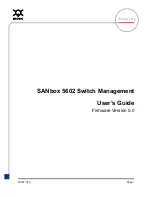
6–8
MULTINET4 MULTI-PORT SERIAL SERVER & MANAGED SWITCH – INSTRUCTION MANUAL
OPERATIONAL GUIDE
CHAPTER 6: OPERATIONAL GUIDE
Learning
– The port is receiving BPDUs and is learning MAC addresses but it s not
forwarding data frames.
Forwarding
– The port is sending and receiving all packets.
Once the RSTP network is functioning all traffic is by definition handled by the ports in the
forwarding state.
6.3.2
RSTP Normal Operation
After initial configuration RSTP functions by circulating BPDUs through the system. When
these BPDUs indicate a change in the topology, such as failure of a link or the addition of a
new node, the system is reconfigured.
System maintenance is carried out by the traffic in BPDUs among the bridges.
Maintenance is managed under certain configurable constraints:
Hello Time
– The amount of time between the transmission of configuration BPDUs on
any port. Valid Range = 1-10 seconds Default value = 2 seconds. A connection is
considered to be lost if hellos are not received for three consecutive times (by default this is
six seconds).
Forward Delay
– Controls how long the bridge waits after any state or topology change
before forwarding the information to the network. Valid Range = 4-30 seconds Default
value = 15 seconds
Maximum Age
– The length of time a configuration BPDU remains valid before it is
discarded.
6.3.3
Design Considerations
The RSTP protocol can make network decisions automatically. In fact, in the absence of
manual intervention the protocol will completely configure the network; however you may
want to specify the settings for some or all of your bridges and ports. For instance, you
may want to ensure that a particular bridge is the root bridge or that a certain port on a
bridge is the designated port.
Note that you
should
use the Port: Settings screen to ensure that ports connecting to end
stations are specified as edge ports, and that ports that connect to other bridges using
RSTP are specified as Point ports (also known as Point-to-Point ports).
6.3.3.1 Configuring Bridge Settings
Use the
4.4.3.1: RSTP: Bridge Settings
screen to configure the following parameters:
•
Enabled –
Any bridge active in the system must have the Disabled/Enabled value
set to Enabled.
•
Priority –
The default priority value is 32768 (in a valid range of 0-65535). If you
know that you want a specific bridge to be the root bridge, then set this value on
that bridge low - lower than any other bridge in the system. You can also
effectively specify a bridge as an alternate root bridge, to take over in the event of
failure of the original root bridge, by giving it a priority value only slightly higher
than that of the root bridge. When you have more than one bridge connecting to
















































